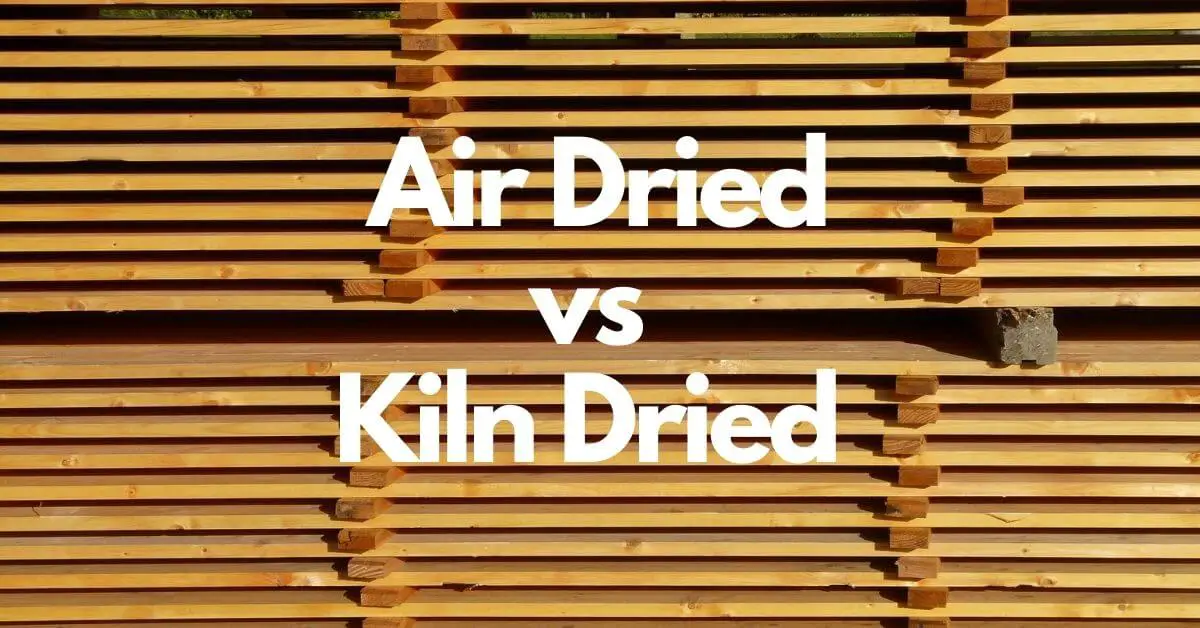Introduction
The process of making lumber begins with harvesting forest trees. Hardwood living trees have about 75% to 80% moisture which is not suitable for burning, furniture, and any projects at all. Wood with 7% to 9% moisture content is suitable for making furniture and below 20% moisture content for firewood.
When the wood begins to dry, it shrinks, changing the width, thickness, and other physical properties, which can cause the joints to open and twist. So we cannot use wet wood for construction without drying it. Use only well-dried wood.
There are several methods of removing moisture from wood or drying the wood. Such as Air drying (air-seasoning) and Kiln drying. The main purpose of all these methods is to evaporate the moisture present in the wood. Each method or process has its advantages and disadvantages. These methods are used according to the project’s needs.
So in this blog, we will know the difference between air drying and kiln drying and their advantages and disadvantages.
| # | Air Drying | Kiln Drying |
| Time | Slow Process, can take up to 8 -16 months. | Fast Process, usually takes 6 – 8 weeks. |
| Cost | Less | Expensive |
| Space Requirement | It requires more space. | It requires less space as compared to Air Drying |
| Temperature | Depends on the atmosphere’s temperature. | 120 to 190 degrees F. |
| Control | There is no control in this process. | Temperature, relative humidity, and air circulation can be controlled. |
| Is the color affected? | No | Yes, the color fades. |
| Do insects die? | No | Yes |
| Uses | Outdoor patio furniture, fencing, and decking | Furniture, cabinets, and flooring |
Air Drying Lumber
Air drying is the basic and least expensive method and natural way to dry wood. This method does not require a lot of resources. This process is done through natural resources.
To air dry, lumber is arranged in layers. Small wooden blocks (stickers) are used to keep enough gaps (Maintain at least 1 inch) between each layer. There should be enough gaps between the layers that air can easily pass from one end to the other.
Air drying is done in an open space where there is a constant flow of air. These layers of wood were kept under the shade. So that the weather does not have a bad effect on the lumber.
Air drying is a slow process that can take more than 1 year. To speed up this process, multiple fans can be installed in one direction.
How long does it take to air dry?
It depends on the species, thickness of wood, and climate. But It may take 3 to 12 months to bring 4/4 lumber from green to air-dry. Drying occurs rapidly in summer while slow in cold and winter.
Use of Air Dried Wood
When the use of wood does not require a low moisture content, Air-dried wood is usually a great option. Air Dried Wood used for outdoor furniture, barns, poles sheds, fencing, decking, and garages.
Advantages of Air Drying
1. Low Capital cost
The air-drying method is less expensive than other drying methods. Hence it is the most preferred process. It requires only a shady place. The moisture present in the wood can be measured through Digital Moisture Meter. Everything is done manually in this process.
2. Less chance to mold and decay
Experts agree that air-dried wood is less prone to mold and insects.
3. Less chance to Cracks
Air Dried lumber is evenly dried naturally, with minimal cracking and no stress in the wood grains. So there is less chance of cracking in the bending process.
4. Natural color remains
Wood retains its natural color during the Air drying process. Whereas by kiln drying the wood fades from its natural color. The effect of fade is more visible in hardwood(dark wood).
The disadvantage of Air Drying
1. Slow Process
As we know that air drying is completely natural. It has to depend on the temperature of the season. Therefore the drying rate of this process is less as compared to Kiln drying.
The rule of thumb is to let the lumber air-dry for one year for each inch of thickness. The high demand for wood cannot be met by this method.
2. No Control
There is no control, It is completely dependent on the climate. The process becomes very slow during wet and rainy days.
Kiln Drying Lumber
Kiln drying is another method to remove moisture from the lumber. In this method, the lumber is kept in a closed chamber(Kiln), where the temperature, humidity, and air circulation are controlled.
For kiln drying, the wood is arranged in layers in a closed chamber, where the air is passed through the wood layers by several fans. The fan speed is regulated as per the requirement.
Kiln drying is a faster and more effective method than air drying. The temperature of the closed chamber ranges from 120 to 190 degrees F. Softwoods and low-density hardwood dry quickly. Whereas high-density hardwood takes a higher temperature and longer time to dry.
How long does it take to kiln dry wood?
It takes about 6- to 8 weeks for 1-inch thickness lumber to dry properly. 2.25” thick slab which is a very common slab thickness, it may take about 3 months to dry. But it also depends on many factors such as type of wood and moisture content.
Use of Kiln Dried Wood
When the use of wood does require a low moisture content and well-dried wood. Then Kiln-dried wood is the perfect option. Kiln Dried Wood used for furniture, cabinets, and flooring.
Advantages of Kiln Drying
1. Fast Process
The main purpose of Kiln Drying was to speed up the process of wood drying. Nowadays, most wood production mills bring down the moisture content of the green lumber to the desired level by the Kiln method. This process saves a lot of time.
2. Control
In the Kiln drying method, we can completely control the temperature, relative humidity, and air circulation of the chamber.
3. Dry well
As we know, high temperatures can be generated and controlled. Therefore wood dries much better than air drying. For indoor furniture or flooring, people use kiln-dried wood.
Typically Kiln-dried wood has a moisture content of around 6% to 8%. So lightweight wood is easy to transport and work.
4. Kills Bugs
The temperature of the kiln chamber can be 120 to 190 degrees Fahrenheit. At this temperature insects, eggs, bug larvae, mold, and fungi get killed and increase the durability of lumber.
5. Required less space
Kiln Drying requires less space as compared to Air Drying. Less space can be placed between each layer.
The disadvantage of Kiln Drying
1. Expensive
Kiln-drying plants are expensive to build, manage or operate. Therefore kiln-dried wood is 15% to 20% more expensive than air-dried wood.
2. Required Technical operators
Must have knowledge of machine and temperature to operate the kiln process. You need multiple technical operators for a plant. So that according to wood species and drying stage, the temperature can be controlled.
3. Color Fades
It is often seen that the color of kiln-dried wood fades by 20%, as compared to air-dried. This happens due to the forced drying of the wood.
4. Internal Tensions
The kiln drying process creates internal tensions in the wood grains. It can break off easily, especially when working with hand tools. There is a problem while working.
5. Absorbs Moisture Quickly
Kiln Dried wood is more likely to absorb moisture after being taken out of the kiln. Therefore kiln-dried wood needs to be kept in a climate-controlled environment after the complete process.
Cooking with Air Dried vs Kiln dried

Air drying and natural seasoning wood are much better for barbeque. Because it dries naturally. Which burns well and generates proper temperature.
Air Dried vs Kiln Dried | Which one is better?
Which is better? This is a matter of debate. Some people like air-dried wood because the wood does not lose its natural color. Some people like Kiln-dried wood because it dries faster and better.
But I personally believe that air-dried lumber is better than kiln-dried lumber. Because Air-Dried wood is more stable and natural, It is not forced dried through high temperatures and artificial environment.

